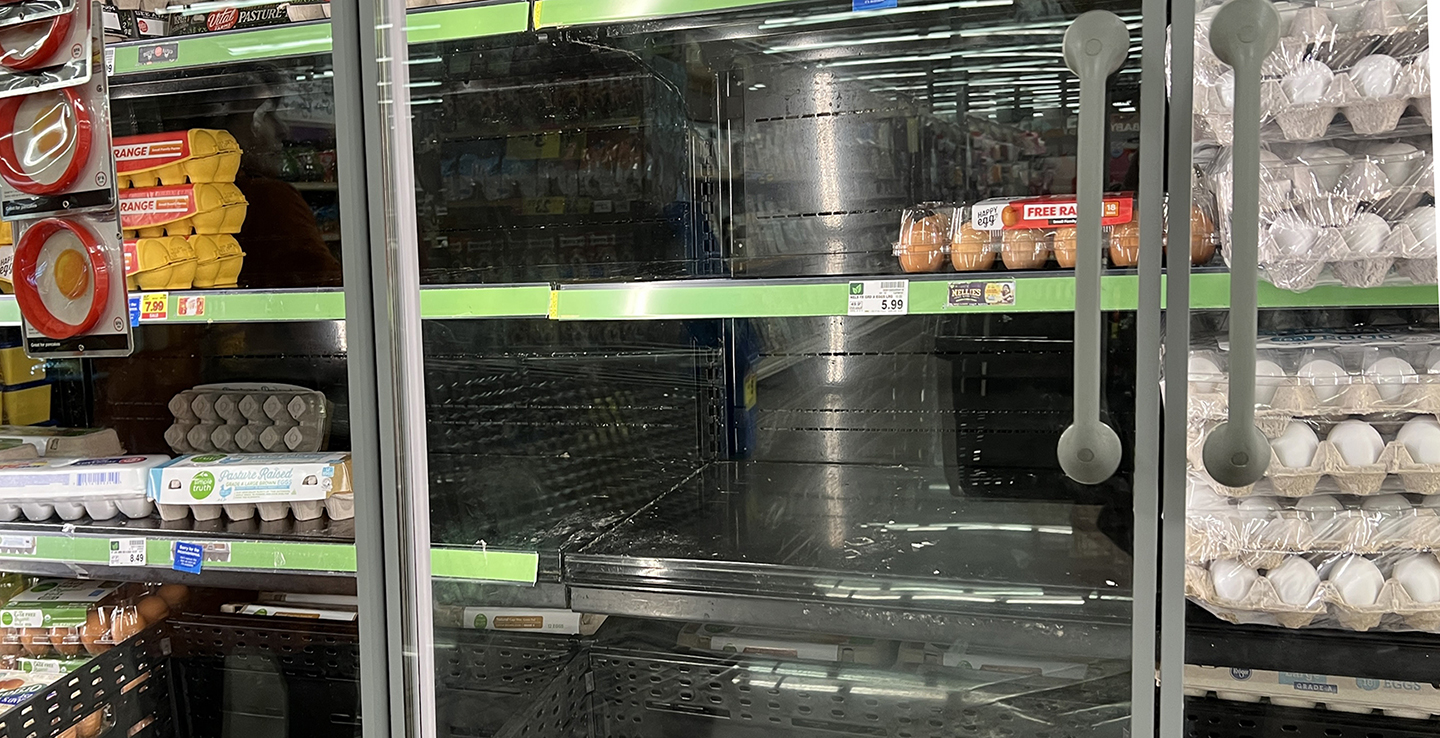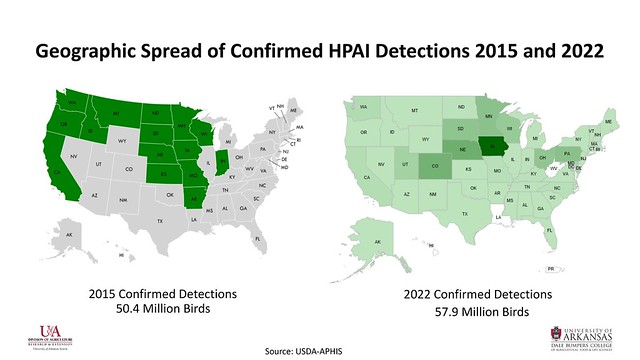Consumers can expect egg prices to decline, but not to 2021 levels
“The cost of feed for eggs has gone up something like 29.5 percent,” Thompson said. “That’s a substantial portion of the cost that goes into producing an egg.”
By Mary Hightower
U of A System Division of Agriculture
Jan. 24, 2023
Fast Facts
- Food prices easing across the board
- Highly pathogenic avian influenza continues to affect poultry
(766 words)
(Newsrooms: SUBS 16th graf, to CORRECT "are" to "and;" with art of Thompson, graphs showing price movement)
FAYETTEVILLE, Ark. — Egg prices won’t stay high forever, but with no clear end in sight for the current round of highly pathogenic avian flu, prices won’t descend to bargain basement levels, said Jada Thompson, a poultry economist for the University of Arkansas System Division of Agriculture.
In 2022, average U.S. retail prices for eggs rose from just under $2 per dozen to more than $4 a dozen. That compares with 2021, in which egg prices in January were below $1.50. The average retail price rose lazily through the year, but never reached $2 a dozen.

“Highly pathogenic avian flu, or HPAI, has devastated the poultry industry in the U.S.,” Thompson said. “We are about 5 to 6 percent down in our layer flock, leading us to be down in our egg supply 5-6 percent year over year.”
However, HPAI is just one of the factors driving up the price of eggs since last fall.
“Add other factors like inflation, and there’s fuel, which is impacting our transportation. Plus, you have driver shortages and that increases the cost of production and getting eggs to the market.
You have things like high demand in November and December — everybody wants those deviled eggs,” she said. “Then you add the war in Ukraine, which you don’t think about affecting eggs directly, but that affects global feed supply and trade around the world.”
Corn and soybeans play a big role in chicken feed, she said. Raising those crops has become more expensive thanks to fertilizer and diesel prices pushed higher by the Ukraine conflict.
“The cost of feed for eggs has gone up something like 29.5 percent,” she said. “That’s a substantial portion of the cost that goes into producing an egg.”
Outlook
Consumer price index, or “CPI, numbers are coming out and we are seeing some reduction in inflation, so that’s the easing of food prices in general,” Thompson said. “We’re seeing some of the wholesale, even retail prices coming down.”
Thompson said she and other economists will be looking at how bird flu affects the markets and the supply chain. However, there is no instant fix, since replenishing the supply of hens takes time.
“We don’t have a million birds laying around,” she said. “It’s six months before we have a bird ready to lay an egg. It takes 21 days to hatch an egg; five months or 20 weeks to get that chick to maturity.”
Thompson said that in November and December of ’22, the supply of birds was down.
However, “pullets — birds that are between chicks and adults — are up 5 percent,” she said. “The replenishment chain has been trying to reduce the short supply. We’re still hatching.”
While all those activities are easing the supply and prices, Thompson said “egg prices won’t be declining to 2021 levels.”
Worse than 2015
The current avian influenza outbreak is worse than 2015, which was considered the largest animal health event ever. Laying hens and turkeys are more susceptible than other poultry, Thompson said.
Some 50.4 million birds in 15 states were affected by the 2015 outbreak, but the current outbreak has affected 57.9 million birds in 47 states. In 2022, layers comprised 75 percent of the poultry affected by HPAI. Turkeys were next at 16 percent, followed by broilers at 4 percent and breeders at 3 percent. In 2022, Arkansas had HPAI in three flocks affecting 56,470 birds.
What’s difference?
The virus has adapted to not kill its host. “The wild birds are not as susceptible to it. Ducks and geese are not getting it as bad as turkeys and chickens” enabling a wider spread and giving the outbreak a longer life, Thompson said.
In 2015, “hot summers stopped the spread and we saw it die out,” Thompson said.
The only reason the current outbreak isn’t even worse is because industry and backyard flock owners are practicing biosecurity protocols learned from the 2015 outbreak.
“We have doubled down on biosecurity with truck washes, more personal protective equipment, which are used even during non-HPAI times,” she said.
Plus, Thompson said, there is increased surveillance and better reporting “and more communicating and social media reporting of that, and they are helping us know where the wild birds are migrating.”
"I have to give props to producers who have been increasing biosecurity, as well as local, state and federal agencies in communicating a lot more about biosecurity,” Thompson said. “As bad as this current outbreak is, this is us trying to slow this down.”
Fighting fatigue
“Outside this hemisphere, they’ve been fighting it for several years,” said Dustan Clark, extension poultry veterinarian for the Division of Agriculture. “We’re at a lull right now since migration is ceased, but we will fight it through this spring and probably again this fall.”
Clark says he’s seen the effects locally.
“I go to the grocery store and see people look at the eggs and move on,” he said. “Or sometimes, they just don’t find eggs.”
Over the last year, Clark has spoken dozens of times to producers and backyard flock owners and others through meetings and webinars, hammering home the need for biosecurity protocols. He said he would schedule more webinars this spring, when wildfowl start their northward migration.
“Since this virus has been detected in wild waterfowl in every state but Hawaii,” Clark said. “It’s an ongoing concern.”
“We are trying to keep everyone vigilant and hope they don’t get fatigued,” he said. “Once the virus slips in on you, it’s going to be problematic.”
In Arkansas, chicken eggs ranked No. 4 in terms of cash farm receipts at $568 million. Broilers topped the list with at nearly $2.7 billion, according to the latest Arkansas Agriculture Profile.
The Animal and Plant Health Inspection Service, or APHIS, which is part of the U.S. Department of Agriculture, has a site detailing confirmations of HPAI in flocks and a dashboard for tracking wild bird infections.
To learn about extension programs in Arkansas, contact your local Cooperative Extension
Service agent or visit www.uaex.uada.edu. Follow us on Twitter and Instagram at @AR_Extension. To learn more about Division
of Agriculture research, visit the Arkansas Agricultural Experiment Station website: https://aaes.uada.edu. Follow on Twitter at @ArkAgResearch. To learn more about the Division of Agriculture,
visit https://uada.edu/. Follow us on Twitter at @AgInArk.
About the Division of Agriculture
The University of Arkansas System Division of Agriculture’s mission is to strengthen
agriculture, communities, and families by connecting trusted research to the adoption
of best practices. Through the Agricultural Experiment Station and the Cooperative
Extension Service, the Division of Agriculture conducts research and extension work
within the nation’s historic land grant education system.
The Division of Agriculture is one of 20 entities within the University of Arkansas System. It has offices in all 75 counties in Arkansas and faculty on five system campuses.
Pursuant to 7 CFR § 15.3, the University of Arkansas System Division of Agriculture offers all its Extension and Research programs and services (including employment) without regard to race, color, sex, national origin, religion, age, disability, marital or veteran status, genetic information, sexual preference, pregnancy or any other legally protected status, and is an equal opportunity institution.
# # #
Media contact: Mary Hightower, mhightower@uada.edu
